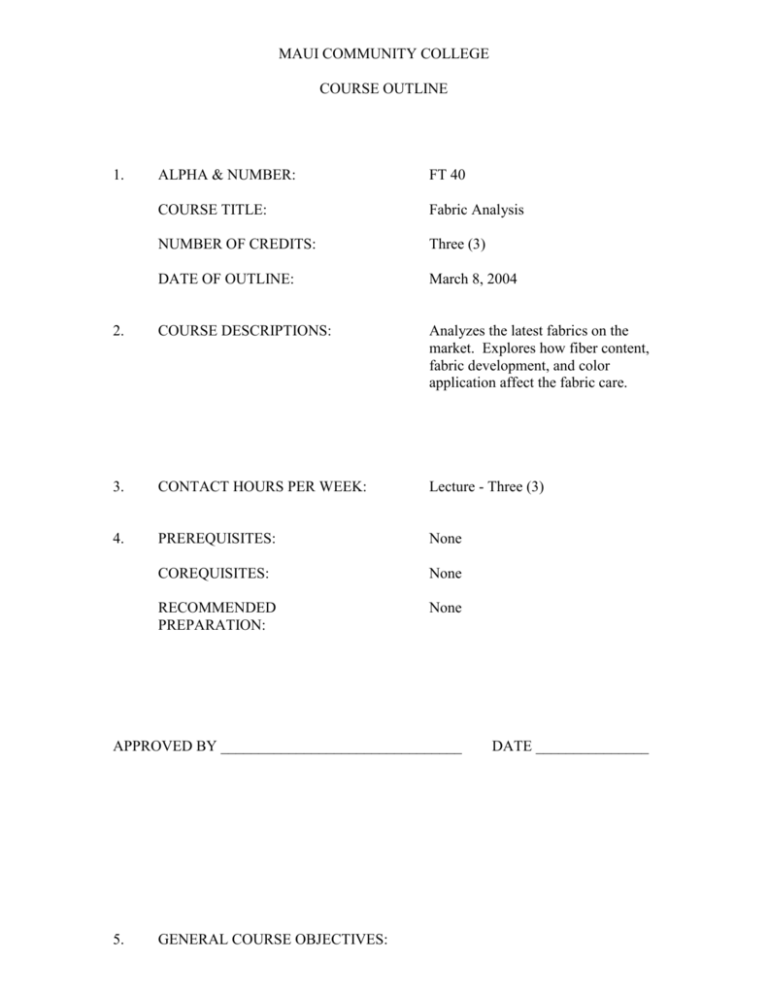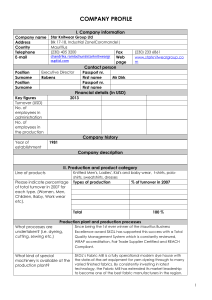maui community college - University of Hawai'i Maui College
advertisement

MAUI COMMUNITY COLLEGE COURSE OUTLINE 1. ALPHA & NUMBER: FT 40 COURSE TITLE: Fabric Analysis NUMBER OF CREDITS: Three (3) DATE OF OUTLINE: March 8, 2004 2. COURSE DESCRIPTIONS: Analyzes the latest fabrics on the market. Explores how fiber content, fabric development, and color application affect the fabric care. 3. CONTACT HOURS PER WEEK: Lecture - Three (3) 4. PREREQUISITES: None COREQUISITES: None RECOMMENDED PREPARATION: None APPROVED BY ________________________________ 5. GENERAL COURSE OBJECTIVES: DATE _______________ To introduce students to a variety of textiles on the market further exploring fiber content, yarn development, fabric construction and surface applications. In addition, visual and tactile identification, home laboratory tests and sewing with a variety of textiles will be explored. 6. 7. 8. STUDENT LEARNER OUTCOMES: Upon completion of this course, students will be able to: a) Describe the importance of the textile industry in the fashion industry. b) Describe textile legislation regulating fiber content and care labeling. c) Become familiar with sources and properties of natural and man-made fibers. d) Perform simple physical tests in identifying fiber content. e) Demonstrate an understanding of manufacturing of fibers, yarns and fabrics. f) Identify the various yarns, weaves, and knit stitches used in fabrics. g) Demonstrate an understanding of and identify coloring and finishing techniques used on fabrics. h) Recommend appropriate seam and/or seam finish for specific textiles. i) Recommend appropriate care procedures of various fabrics. RECOMMENDED COURSE CONTENT: A. Fibers – natural and man-made fiber burn testing B. Yarns C. Fabric Structure – woven, knits and non-wovens paper weaving other – lauhala, loom or pin weaving D. Surface Appearance – dyeing and printing E. Finishes F. Fabric care and stain removal stain removal testing G. Specialty fabric stitching techniques RECOMMENDED COURSE REQUIREMENTS: Specific course requirements are at the discretion of the instructor. Suggested requirements might include, but are not limited to: Fabric swatch reference workbook Student assignments Participation in workshops Research paper Quizzes/exams 9. TEXT/MATERIALS/SUPPLIES: Text: Shaffer, Claire; Fabric Sewing Guide, updated edition, Chilton Book Co. ATEX Inc., The Textile Kit, latest edition. Text may be supplemented with: Instructor handouts Internet resources Videos Current event periodicals Field trip Guest speaker/demonstrator for workshops Student Supplies: fabric shears tweezers double stick tape specialty fabric (assigned) 10. 11. 12" C-thru ruler weaving supplies EVALUATION/GRADING: Fabric reference workbook Assignments/workshops (may include the following): consumer ad research fabric burn testing heat setting paper and lauhala weaving knittting fiber/fabric shrinkage fabric dyeing screen print stain removal stitching samples MIDTERM research paper FINAL exam METHODS OF INSTRUCTION: Suggested methods might include, but are not limited to: Lecture Demonstrations Class discussion Student presentations Workshop presentations FT40 thread clippers pins pencils 50% 20% 10% 20%











